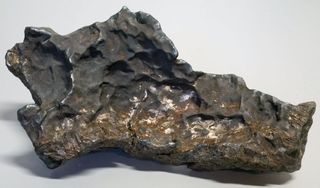Stephanie Pappas is a contributing writer for Space.com sister site Live Science, covering topics ranging from geoscience to archaeology to the human brain and behavior. She was previously a senior writer for Live Science but is now a freelancer based in Denver, Colorado, and regularly contributes to Scientific American and The Monitor, the monthly magazine of the American Psychological Association. Stephanie received a bachelor's degree in psychology from the University of South Carolina and a graduate certificate in science communication from the University of California, Santa Cruz.
Latest articles by Stephanie Pappas

Never-before-seen colossal comet on a trek toward the sun
By Stephanie Pappas published
A new visitor is swinging by the solar system: a never-before-observed comet that hails from the Oort Cloud.

Expect an Orwellian future if AI isn't kept in check, Microsoft exec says
By Stephanie Pappas published
Speaking on the BBC show 'Panorama,' Microsoft's Brad Smith warned that unless checks are put in place, artificial intelligence could lead to a dystopian future

Satellites may have been underestimating the planet's warming for decades
By Stephanie Pappas published
Satellite observations of different climate variables don't quite add up, suggesting these measurements might be missing something about the atmosphere.

Earth nearly lost all its oxygen 2.3 billion years ago
By Stephanie Pappas published
The permanent oxygenation of Earth's atmosphere took twice as long as previously believed and finally finished up to 100 million years later than expected.

Hidden boundaries of lost continent 'Zealandia' revealed in incredible detail
By Stephanie Pappas published
The lost continent is a submerged chunk of crust that broke off from Gondwana 80 million years ago.

To be declassified: UFO broke sound barrier with no sonic boom
By Stephanie Pappas last updated
Former Trump intelligence director John Ratcliffe told Fox News that more unexplained sightings of flying objects will soon be declassified.

Why Russian scientists just deployed a giant telescope beneath Lake Baikal
By Stephanie Pappas published
The enormous Baikal-GVD will look for the particles from 4,300 feet (1,310 meters) below the lake surface.

Meet the swirlon, a new kind of matter that bends the laws of physics
By Stephanie Pappas published
A new form of active matter known as swirlonic matter clumps together in quasi-particles that bend the laws of physics.

Rare red sprite and blue jet create otherworldly light show above Hawaii
By Stephanie Pappas published
A camera at an observatory in Hawaii captured a red sprite and a blue jet in the same frame.

Lumpy, 30-pound meteorite that crashed in Sweden recovered in local village
By Stephanie Pappas published
Two meteor enthusiasts have found a piece of an iron meteorite that fell over Sweden in November 2020.

Cosmologists create 4,000 virtual universes to solve Big Bang mystery
By Stephanie Pappas published
Cosmologists simulated 4,000 versions of the universe in order to understand what its structure today tells us about its origins.

Dinosaur-killing space rock may have originated at the edge of the solar system
By Stephanie Pappas published
The chunk of space rock that killed the nonavian dinosaurs may have been a piece of a comet that Jupiter's gravity kicked onto a collision course with Earth.

Particles zipping around Earth at near light-speed finally explained
By Stephanie Pappas published
When the plasma of the Van Allen belts drops in density during a solar storm, it can set up the perfect conditions for electrons to travel nearly as fast as light.

Mystery particle may explain extreme X-rays shooting from the 'Magnificent 7' stars
By Stephanie Pappas published
Particles called axions may be the reason the 'Magnificent 7' cluster of neutron stars emits extreme X-rays.

Earth is whipping around quicker than it has in a half-century
By Stephanie Pappas published
It could mean a "negative" leap second.

Physicists could do the 'impossible': Create and destroy magnetic fields from afar
By Stephanie Pappas published
The ability to cancel and induce magnetic fields from a distance could improve biomedicine.

Explosive growth of Colorado wildfire seen from space
By Stephanie Pappas published
The spread of the fire was visible from space.

Meet the zeptosecond, the shortest unit of time ever measured
By Stephanie Pappas published
Scientists have measured the shortest unit of time ever, the time it takes for a particle of light to cross a hydrogen molecule.

'Lost' tectonic plate called Resurrection hidden under the Pacific
By Stephanie Pappas published
A new computer reconstruction of the tectonic plates of 60 million years ago reveals the existence of a lost plate called Resurrection.

Severe burn damage from California wildfires seen from space
By Stephanie Pappas published
New satellite imagery of California reveals not just the extent of its wildfire damage, but the depth of the loss.

Black hole-sized magnetic fields could be created on Earth, study says
By Stephanie Pappas published
The magnetic fields are more than a thousand times stronger than the magnetic field used in MRI machines..

Stark new imagery reveals the scary extent of West Coast wildfires
By Stephanie Pappas published
Smoke blankets the West Coast in the new images.

Earth's core is a billion years old
By Stephanie Pappas published
The solidification of the inner core may have strengthened Earth's magnetic field.
Breaking space news, the latest updates on rocket launches, skywatching events and more!



